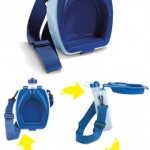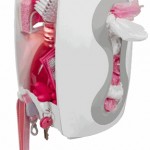When and How Do I Train My Puppy?
Anyone who has ever had a dog knows that training a new puppy is a challenge, but essential. With any new dog, puppy training starts the day that you bring your new pet home and continues for months as they continue to learn the basics becoming a part of the family. By the time you bring your new puppy home they are ready to learn. In fact, puppies can be trained from a very early age as long as we don’t expect too much of them right away. By natural design the mother dog has been educating her litter for several weeks, preparing them to survive on their own. By seven weeks the puppy’s development allows him to leave the mother and ensures the strongest human ties and best socialization possible. Older puppies may be less inclined to attach to humans right away, but eventually with love and affection and our constant interaction the bond will be just as strong. No matter what age you bring your puppy home, the important thing to remember is that they are ready to learn, they just need patience and practice!
Dog training at this early stage will focus on the essentials; house training, chewing, digging, jumping, and learning to wear a collar and walk on a leash. The most important thing to remember about training your puppy is that you are creating boundaries and establishing house rules that will be in place for a lifetime, making your time together the best possible. The groundwork you lay today will allow you to have a wonderful, productive relationship with your dog every day.
Responding To His/Her Name: The first place to start training is to begin training your puppy to respond to his name being called. You can begin by calling the puppy’s name as you feed him his meals so that the puppy starts to associate his or her name with his food- a good thing! After a few days you can change the order, so that you call his name, wait for him to look at you, and then give him a treat. Once he’s responding on a regular basis, you can phase out the treats, using your voice (good puppy!) and your and petting to praise him and let him know that you are pleased with him. Treats can still be used on an unpredictable schedule as a reward, but the puppy is responding to your voice and praise more than looking for his payment of the food or treats. Having your dog recognize his name and respond by looking at you will prepare him for dog obedience, puppy training classes and more!
House Training On his first day in your home you should begin house training your puppy. Most people are surprised, but house training is one of the easiest things to teach a dog. Because dogs are clean by nature and do not want to soil their ‘den’, it can be particularly useful to use the crate method of house training. The first thing to keep in mind with house training is that you must supervise your puppy closely and give the pup the chance to go outside when he has to relieve herself.
Young puppies are not ready to have full access to your whole house, it will overwhelm and either intimidate or over-excite them. One of the biggest pitfalls in house training fails is when people allow their puppy more freedom than he can handle within the home and don’t supervise his initial experiences going potty outside. It is important for owners to set aside time to take the new puppy out, watch them go and bring them back in so that the puppy begins to understand how you want them to handle their natural urges. We can give a general outline of what you can need to do to maximize house training, remember that you should always consult a professional trainer to guide you through the process.
Method One: Crate Training You can tap into the puppy’s natural desire to be clean and not soil the area in which he sleeps by using a crate. Using a crate to replicate the safe, secure “den” environment can aid your house training efforts, as long as he is given the opportunity to get out of his crate when necessary.
After hooking the puppy to a leash, let him out from the dog crate and take him out to the area, the backyard, a nearby park or green space, where you want him to ‘go’ or ‘eliminate’. If he goes, praise him. If he does not then put him back into his crate and try again in about 15 minutes or so. Continue with this dog training cycle, building a routine for you and your dog. If an outing is successful, then you can allow the pup some freedom for twenty minutes or so and you can gradually extended the time as he grows older and more reliable about not having accidents in the house. Remember a seven-week-old puppy does not have a great deal of bladder control, so accidents are nearly impossible to avoid completely. You can not expect the puppy to go more than a few hours without having to eliminate, and don’t expect him to wait once he is out of his crate to go, instead take him straight outside to avoid any problems.
Before taking your puppy out for the first time, decide what word or phrase you would like to associate with his behavior or action that you desire. In the beginning, the puppy won’t understand the word, but if you use “hurry up”, or “go potty” and continue to repeat the phrase until he goes, praising him/her when it happens, your puppy will learn to associate these words with the action. Later, when in a hurry or inclement weather you can use the cue word to get your dog to relieve himself in quick time, without having to wait in the scorching sun, or freezing rain.
Method Two: Crate Training with Doggy Door Another, and many say easier, method for house training is to use a crate with a dog door and an enclosed dog run. First, you position the dog crate against the dog door which will allow the dog to go out whenever he needs. Because his small size, the dog door may need to be taped or otherwise rigged up so the puppy can comfortably go through the dog door. With the crate set up to the dog door, your puppy learns quickly to let himself out of his containment area to relieve himself. This method also helps him develop some independence always having his human to watch over him. One important thing to consider with this system is that when you first let your puppy out of his crate, you should still take your puppy immediately to the outside area so that he can go. Even though your crate has access to the outside, puppy may have been resting and not recently “emptied out.” It won’t take much excitement or physical movement for the puppies need to “go” to be present and we don’t want mistakes that could easily have been prevented.
When the pup isn’t in his crate, you need to use constant supervision to keep him from having accidents. The best way to have a constant eye on your puppy is to literally tie or tether the pup to your waist with a leash or line, or you can tether him to a piece of furniture, but be sure that he has no more than three feet of freedom in any direction. Remember that a puppy tethered to furniture should be watched carefully or he may chew it. Crating, supervising and tethering are examples of management systems used to support the dog until he is fully trained.
Because dogs are inherently pack animals, they prefer to be with us rather than to be alone. Most cases of adult “separation anxiety” would never develop if the dog, as a puppy, had been trained in the one of the management systems just described because early on the puppy would learn to deal with being alone, handling is own needs, without access to chew or destroy things. Give it a try and see if it benefits your new puppy and your family.
Remote Collar Training: Have you wondered if using a remote electronic collar can work for training a puppy? The answer is, yes. Why? Because the Sit Means Sit remote collar training system, developed by Fred Hassen, is a proven, effective and gentle training method tailored individually to your dog’s needs. Dog training, obedience, puppy, and even agility training are well suited to the remote collar training method. Sit Means Sit uses the better quality remote collars on the market, which means that these are fully adjustable for different dogs. The remote collar is used as a cue system similar to a tap on the shoulder that says “yoo-hoo” to someone in an effort to let them know you are talking to them. In other words, the collar is never used with a puppy as punishment, but instead as a means to successfully gain the puppy’s attention. In any case, you should seek a professional’s advice and aid in this type of training to avoid any elements of confusion for your pup.
Is there a specific age at which dogs can begin remote collar training? No. Common sense will tell you when your dog is physically coordinated enough to go for walks on a leash, which is a good indicator that he is ready for further training. Another indicator may be when he is active enough that you feel he is ready for more advanced training. He’s your pup knowing when he is ready for further training is personal choice akin to whether your child is ready for kindergarten. Some children are ready at just under five while some need another year. Pups, like kids, mature at individual rates. He’s your puppy, enjoy him but remember he needs rules, supervision, attention, exercise, good positive mental outlets, good food and lots of rest to grow up strong, healthy and well behaved!
Blair Stephens is a proud member of the Sit Means Sit team, spreading the word about dog training and remote electronic collar training! Come see more articles from the Sit Means Sit team at www.sitmeanssit.com.
The best way to absorb pet urine from furniture and carpets is with a Super Shammy.Â
Got a stain that won’t come clean? Try Quick’n Brite for pet urine and feces stains.Â





 Ordering Info
Ordering Info Customer Service
Customer Service Follow Us
Follow Us Search For Stuff
Search For Stuff Find Us
Find Us Call Us
Call Us Pay Us
Pay Us

Hi! I was surfing and found your blog post… nice! I love your blog. 🙂 Cheers! Sandra. R.
Fantastic information in your posting, I saw a report on television last week about this same thing and since I am going to be married next month and the timing couldn’t have been better! thanks for the post!, I have bookmarked, thanks Sue Zaki
Has anyone had good luck with Iams dog food? It seems a little pricey but if it is as good as the ads say then maybe it is worth it. Looking for any opinions 🙂